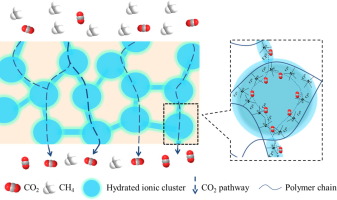当前位置:
X-MOL 学术
›
Chem. Eng. Sci.
›
论文详情
Our official English website, www.x-mol.net, welcomes your
feedback! (Note: you will need to create a separate account there.)
Constructing interconnected ionic cluster network in polyelectrolyte membranes for enhanced CO2 permeation
Chemical Engineering Science ( IF 4.1 ) Pub Date : 2019-05-01 , DOI: 10.1016/j.ces.2018.12.050 Zihan Qu , Hong Wu , Yue Zhou , Leixin Yang , Xingyu Wu , Yingzhen Wu , Yanxiong Ren , Ning Zhang , Yutao Liu , Zhongyi Jiang
Chemical Engineering Science ( IF 4.1 ) Pub Date : 2019-05-01 , DOI: 10.1016/j.ces.2018.12.050 Zihan Qu , Hong Wu , Yue Zhou , Leixin Yang , Xingyu Wu , Yingzhen Wu , Yanxiong Ren , Ning Zhang , Yutao Liu , Zhongyi Jiang

|
Abstract Membranes with fast CO2 transport pathways have attracted intense attention due to their outstanding CO2 permeability, showing potential for industrial application. Regulating the spatial distribution of CO2-philic groups in polymer-based membranes is expected to be a promising strategy to achieve the fast CO2 transport pathways. In membrane matrix, the interconnected network of concentrated domains of CO2 facilitated transport groups provides membranes with specific CO2 transport pathways and finally leads to their high separation performance. In this study, a novel kind of polyelectrolyte membrane, quaternary ammonium polysulfone with interconnected ionic clusters, is prepared to enhance the CO2 permeability. The hydrophilic quaternary ammonium groups tend to aggregate spontaneously to create ionic clusters. Furthermore, under humidified conditions, these ionic clusters are connected by water to form an ionic cluster network in the membrane matrix. The ionic cluster network plays the crucial role in accelerating the selective transport for CO2 molecules over CH4 by the reversible interaction between CO2 and ion pairs. By tuning the quaternization degree of polysulfone, a series of polyelectrolyte membranes with different size of ionic clusters were developed. Membranes with hydrated ionic clusters (5–9 nm) show dramatic enhancement in CO2 separation performance, especially in CO2 permeability. The as-prepared quaternary ammonium polysulfone membrane with 8.98 nm ionic clusters exhibited the high CO2 permeability of 1109.44 Barrer and a high CO2/CH4 selectivity of 29.70, which exceeds 2008 Robeson upper bound limit. The optimized separation performance of QA-PSf membranes is attractive for potential application such as CO2 capture from flue gas and natural gas.
中文翻译:

在聚电解质膜中构建互连的离子簇网络以增强 CO2 渗透
摘要 具有快速 CO2 传输途径的膜因其出色的 CO2 渗透性而受到广泛关注,显示出工业应用潜力。调节基于聚合物的膜中亲 CO2 基团的空间分布有望成为实现快速 CO2 传输途径的有前途的策略。在膜基质中,CO2 促进传输基团的集中域的互连网络为膜提供了特定的 CO2 传输途径,最终导致其高分离性能。在这项研究中,制备了一种新型聚电解质膜,即具有互连离子簇的季铵聚砜,以提高 CO2 渗透性。亲水季铵基团倾向于自发聚集以产生离子簇。此外,在加湿条件下,这些离子簇通过水连接,在膜基质中形成离子簇网络。离子簇网络通过 CO2 和离子对之间的可逆相互作用,在加速 CO2 分子通过 CH4 的选择性传输中起着至关重要的作用。通过调节聚砜的季铵化程度,开发了一系列不同大小离子簇的聚电解质膜。具有水合离子簇 (5-9 nm) 的膜在 CO2 分离性能方面表现出显着增强,尤其是在 CO2 渗透性方面。所制备的具有 8.98 nm 离子簇的季铵聚砜膜表现出 1109.44 Barrer 的高 CO2 渗透率和 29.70 的高 CO2/CH4 选择性,超过 2008 年 Robeson 上限。
更新日期:2019-05-01
中文翻译:

在聚电解质膜中构建互连的离子簇网络以增强 CO2 渗透
摘要 具有快速 CO2 传输途径的膜因其出色的 CO2 渗透性而受到广泛关注,显示出工业应用潜力。调节基于聚合物的膜中亲 CO2 基团的空间分布有望成为实现快速 CO2 传输途径的有前途的策略。在膜基质中,CO2 促进传输基团的集中域的互连网络为膜提供了特定的 CO2 传输途径,最终导致其高分离性能。在这项研究中,制备了一种新型聚电解质膜,即具有互连离子簇的季铵聚砜,以提高 CO2 渗透性。亲水季铵基团倾向于自发聚集以产生离子簇。此外,在加湿条件下,这些离子簇通过水连接,在膜基质中形成离子簇网络。离子簇网络通过 CO2 和离子对之间的可逆相互作用,在加速 CO2 分子通过 CH4 的选择性传输中起着至关重要的作用。通过调节聚砜的季铵化程度,开发了一系列不同大小离子簇的聚电解质膜。具有水合离子簇 (5-9 nm) 的膜在 CO2 分离性能方面表现出显着增强,尤其是在 CO2 渗透性方面。所制备的具有 8.98 nm 离子簇的季铵聚砜膜表现出 1109.44 Barrer 的高 CO2 渗透率和 29.70 的高 CO2/CH4 选择性,超过 2008 年 Robeson 上限。













































 京公网安备 11010802027423号
京公网安备 11010802027423号